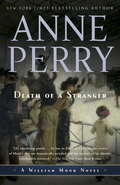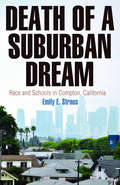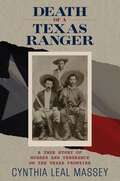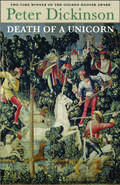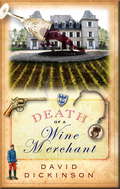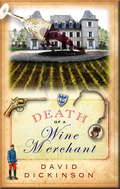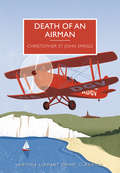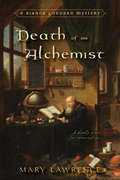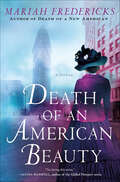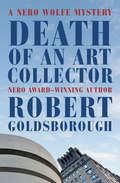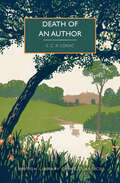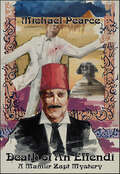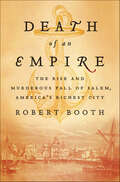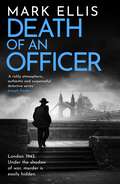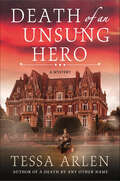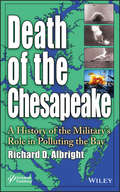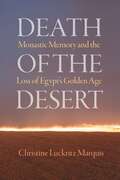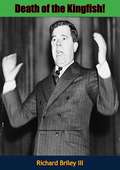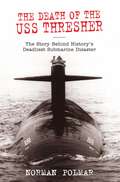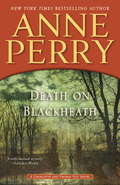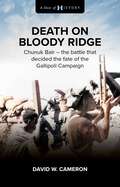- Table View
- List View
Death of a Stranger: The Master Storyteller Of Victorian Society (William Monk Novel Ser. #13)
by Anne PerryFew authors have written more mesmerizingly about Victorian London than Anne Perry. Readers enter her world with exquisite anticipation, and experience a rich variety of characters and class: aristocrats living in luxury, flower sellers on street corners, ladies of the evening seeking customers on gaslit streets, gentlemen in hansom cabs en route to erotic diversions unknown in their Mayfair mansions. Now Perry gives her myriad fans the book they’ve been waiting for—the novel in which William Monk brea...
Death of a Suburban Dream
by Emily E. StrausCompton, California, is often associated in the public mind with urban America's toughest problems, including economic disinvestment, gang violence, and failing public schools. Before it became synonymous with inner-city decay, however, Compton's affordability, proximity to manufacturing jobs, and location ten miles outside downtown Los Angeles made it attractive to aspiring suburbanites seeking single-family homes and quality schools. As Compton faced challenges in the twentieth century, and as the majority population shifted from white to African American and then to Latino, the battle for control over the school district became symbolic of Compton's economic, social, and political crises.Death of a Suburban Dream explores the history of Compton from its founding in the late nineteenth century to the present, taking on three critical issues--the history of race and educational equity, the relationship between schools and place, and the complicated intersection of schooling and municipal economies--as they shaped a Los Angeles suburb experiencing economic and demographic transformation. Emily E. Straus carefully traces the roots of antagonism between two historically disenfranchised populations, blacks and Latinos, as these groups resisted municipal power sharing within a context of scarcity. Using archival research and oral histories, this complex narrative reveals how increasingly racialized poverty and violence made Compton, like other inner-ring suburbs, resemble a troubled urban center. Ultimately, the book argues that Compton's school crisis is not, at heart, a crisis of education; it is a long-term crisis of development.Avoiding simplistic dichotomies between urban and suburban, Death of a Suburban Dream broadens our understanding of the dynamics connecting residents and institutions of the suburbs, as well as the changing ethnic and political landscape in metropolitan America.
Death of a Texas Ranger: A True Story of Murder and Vengeance on the Texas Frontier
by Cynthia Leal MasseyDeath of a Texas Ranger is the thrilling, action-packed story of the murder of Texas Ranger John Green by Cesario Menchaca, one of three Rangers of Mexican descent under Green&’s command. Immediately word spread that the killing may have been the botched outcome of a contract taken out on Menchaca&’s life by the notorious Gabriel Marnoch, a local naturalist who had run up against the law himself. But was it? Much more than just a story about a tragic frontier killing, it is the story of an era. The events leading up to the murder and Green&’s son&’s decades&’ long quest for justice for his father&’s killer exemplify the chaotic frontier society in Texas after the Civil War, a time fraught with political turmoil and cultural clashes. Amidst that chaos, the virgin landscape of Texas was a magnet to those interested in the natural sciences in the nineteenth century, an era often referred to as the Age of Darwin. The clash between the seemingly pastoral landscape with its offerings for science and the brutal history of the region ties this very readable regional history into the larger American story.
Death of a Unicorn
by Peter DickinsonFor best-selling author Lady Margaret, the past is no longer a pleasant memory. Her first lover's mysterious death and the seeming inevitability of her inheriting the family's stately home are cast in new light by secrets unwillingly revisited. The first in a series of reprints of Peter Dickinson's mysteries, this classic British mystery will win fans currently engrossed in Downton Ab-bey. Peter Dickinson has twice received the Crime Writers' As-sociation's Gold Dagger. He lives in England and is married to the novelist Robin McKinley.
Death of a Wine Merchant
by David DickinsonAn unwelcome guest - Death - gatecrashes a society wedding and Lord Francis Powerscourt is summoned by his barrister friend, Charles Augustus Pugh, to investigate this most singular case of murder in the Fens. The dead man is Randolph Colville, successful wine merchant and father of the groom. The murderer would appear to be his brother Cosmo, found in the same room with a gun in his hand. But is this simply a modern-day version of Cain and Abel, or is there more to it than that? Cosmo isn't speaking and time is running out for him for he has an appointment with the gallows in two weeks. Francis has to act fast and sets out to discover all he can about the dead man - and his brother. Cosmo's silence is bothering him for it can only be for two reasons; either he is protecting a woman - or a family scandal. His investigations take him to the vineyards and towns of Burgundy, where he uncovers evidence of serious malpractise in the Colville wine trade, bitter rivalry with a London-based competitor and a disgruntled ex-employee bent on revenge. But there is another secret - more terrible and shocking than anything gone on before - which finally reveals the motive for the untimely death of a wine merchant. Praise for David Dickinson:'Splendid entertainment' Publishers Weekly'A leisurely period whodunit with Dickinson's customary historical tidbits and patches of local color, swathed in an appealing Victorian narrative' Kirkus Reviews'Detective fiction in the grand style' James Naughtie'A cracking yarn, beguilingly real from start to finish' Peter Snow
Death of a Wine Merchant
by David DickinsonAn unwelcome guest - Death - gatecrashes a society wedding and Lord Francis Powerscourt is summoned by his barrister friend, Charles Augustus Pugh, to investigate this most singular case of murder in the Fens.The dead man is Randolph Colville, successful wine merchant and father of the groom. The murderer would appear to be his brother Cosmo, found in the same room with a gun in his hand. But is this simply a modern-day version of Cain and Abel, or is there more to it than that? Cosmo isn't speaking and time is running out for him for he has an appointment with the gallows in two weeks.Francis has to act fast and sets out to discover all he can about the dead man - and his brother. Cosmo's silence is bothering him for it can only be for two reasons; either he is protecting a woman - or a family scandal. His investigations take him to the vineyards and towns of Burgundy, where he uncovers evidence of serious malpractise in the Colville wine trade, bitter rivalry with a London-based competitor and a disgruntled ex-employee bent on revenge. But there is another secret - more terrible and shocking than anything gone on before - which finally reveals the motive for the untimely death of a wine merchant.Praise for David Dickinson:'Splendid entertainment' Publishers Weekly'A leisurely period whodunit with Dickinson's customary historical tidbits and patches of local color, swathed in an appealing Victorian narrative' Kirkus Reviews'Detective fiction in the grand style' James Naughtie'A cracking yarn, beguilingly real from start to finish' Peter Snow
Death of a Wine Merchant (Lord Francis Powerscourt #10)
by David DickinsonAn unwelcome guest - Death - gatecrashes a society wedding and Lord Francis Powerscourt is summoned by his barrister friend, Charles Augustus Pugh, to investigate this most singular case of murder in the Fens.The dead man is Randolph Colville, successful wine merchant and father of the groom. The murderer would appear to be his brother Cosmo, found in the same room with a gun in his hand. But is this simply a modern-day version of Cain and Abel, or is there more to it than that? Cosmo isn't speaking and time is running out for him for he has an appointment with the gallows in two weeks.Francis has to act fast and sets out to discover all he can about the dead man - and his brother. Cosmo's silence is bothering him for it can only be for two reasons; either he is protecting a woman - or a family scandal. His investigations take him to the vineyards and towns of Burgundy, where he uncovers evidence of serious malpractise in the Colville wine trade, bitter rivalry with a London-based competitor and a disgruntled ex-employee bent on revenge. But there is another secret - more terrible and shocking than anything gone on before - which finally reveals the motive for the untimely death of a wine merchant.Praise for David Dickinson:'Splendid entertainment' Publishers Weekly'A leisurely period whodunit with Dickinson's customary historical tidbits and patches of local color, swathed in an appealing Victorian narrative' Kirkus Reviews'Detective fiction in the grand style' James Naughtie'A cracking yarn, beguilingly real from start to finish' Peter Snow
Death of an Airman: A British Library Crime Classic (British Library Crime Classics #0)
by Martin Edwards Christopher Sprigg"Bubbles over with zest and vitality ... A most ingenious and exciting plot, full of good puzzles and discoveries and worked out among a varied cast of entertaining characters." - Dorothy L. Sayers George Furnace, flight instructor at Baston Aero Club, dies instantly when his plane crashes into the English countryside. People who knew him are baffled - Furnace was a first-rate pilot, and the plane was in perfect condition - and the inquest records a verdict of death by misadventure. An Australian visitor to the aero club, Edwin Marriott, Bishop of Cootamundra, suspects that the true story is more complicated. Could this be a dramatic suicide - or even murder? Together with Inspector Bray of Scotland Yard, the intrepid bishop must uncover a cunning criminal scheme.
Death of an Alchemist (A Bianca Goddard Mystery #2)
by Mary Lawrence&“Colorful alchemical lore and a vividly imagined 1543 London enrich Lawrence&’s engaging . . . sequel to . . . The Alchemist&’s Daughter.&”—Publishers WeeklyIn the mid sixteenth century, Henry VIII sits on the throne, and Bianca Goddard tends to the sick and suffering in London&’s slums, where disease can take a life as quickly as murder . . . For years, alchemist Ferris Stannum has devoted himself to developing the Elixir of Life, the reputed serum of immortality. Having tested his remedy successfully on an animal, Stannum intends to send his alchemy journal to a colleague in Cairo for confirmation. But the next day his body is found and the journal is gone. Bianca, the daughter of an alchemist, is well acquainted with the mystical healing arts. When her husband John falls ill with the sweating sickness, she dares to hope Stannum&’s journal could contain the secret to his recovery. But first she must solve the alchemist&’s murder. As she ventures into a world of treachery and deceit, Stannum&’s death is only the first in a series of murders—and Bianca&’s quest becomes a matter of life and death, not only for her husband, but for herself . . . Praise for The Alchemist&’s Daughter&“Unique characters, a twisty plot and a bold, bright heroine . . . Mystery and Tudor fans alike will raise a glass to this new series.&”—Karen Harper, New York Times bestselling author&“A realistic evocation of 16th century London&’s underside. The various strands of the plot are so skillfully plaited together.&”—Fiona Buckley, author of the Ursula Blanchard Mysteries
Death of an American Beauty: A Novel (Jane Prescott Novels #3)
by Mariah FredericksDeath of an American Beauty is the third in Mariah Fredericks's compelling series, set in Gilded Age New York, featuring Jane Prescott.Jane Prescott is taking a break from her duties as lady’s maid for a week, and plans to begin it with attending the hottest and most scandalous show in town: the opening of an art exhibition, showcasing the cubists, that is shocking New York City. 1913 is also the fiftieth anniversary of Lincoln’s Emancipation Proclamation speech, and the city's great and good are determined to celebrate in style. Dolly Rutherford, heiress to the glamorous Rutherford’s department store empire, has gathered her coterie of society ladies to put on a play—with Jane’s employer Louise Tyler in the starring role as Lincoln himself. Jane is torn between helping the ladies with their costumes and enjoying her holiday. But fate decides she will do neither, when a woman is found murdered outside Jane’s childhood home—a refuge for women run by her uncle.Deeply troubled as her uncle falls under suspicion and haunted by memories of a woman she once knew, Jane—with the help of old friends and new acquaintances, reporter Michael Behan and music hall pianist Leo Hirschfeld—is determined to discover who is making death into their own twisted art form.
Death of an Art Collector: A Nero Wolfe Mystery (The Nero Wolfe Mysteries #14)
by Robert GoldsboroughAn art hoarder&’s suspicious death paints a nasty picture for Nero Wolfe. No matter how fabulously he&’s being courted, infamously dour &“art hog&” Arthur Wordell isn&’t keen on favoring the new Guggenheim Museum with his extensive collection. Even at the urging of his beloved daughter, Nadia. Then, the night after the museum&’s fête, Arthur takes a twenty-story plunge from the window of his Times Square office. Nadia thinks it&’s no mere coincidence. Eccentric, yes. Suicidal, no. Private investigator Nero Wolfe and his assistant, Archie Goodwin, agree. Especially after eyeballing Arthur&’s enemies and sycophants, including his ex-wife, a covetous curator, a troika of obsequious advisors, and an outré Greenwich Village artist anxious to see her work out of storage and on the walls of the &“Guggie.&” For Wolfe, there&’s a problem: Arthur didn&’t leave a will. Without a beneficiary not a soul in Arthur&’s circle is set to benefit from his death. Nor do they show any customary indication of guilt. If anybody can solve a seemingly unsolvable masterpiece of murder, it&’s Wolfe. Unfortunately, this time, New York&’s artful investigator is, admittedly, stumped. Continuing the acclaimed series—which also includes The Battered Badge, Archie Meets Nero Wolfe, Murder in the Ball Park, Archie in the Crosshairs, and Murder, Stage Left—Nero Award–winning author Robert Goldsborough &“does a masterly job with the Wolfe legacy&” (Booklist).
Death of an Author (British Library Crime Classics)
by E.C.R. LoracE. C. R. Lorac spins a twisting tale full of wry humor and red herrings, poking some fun at her contemporary reviewers, who long suspected the Lorac pseudonym to belong to a male author.Vivian Lestrange—celebrated author of the popular mystery novel The Charterhouse Case and total recluse—has apparently dropped off the face of the Earth. After he was reported missing by his secretary Eleanor, whom Inspector Bond suspects to be the author herself, crime and murder are afoot when Lestrange's housekeeper is also found to have disappeared.Bond and Warner of Scotland Yard set to work to investigate a murder with no body and a potentially fictional victim.With copies of the first and only edition incredibly rare today, Death of an Author returns to print for the first time since 1935. This edition includes an introduction by CWA Diamond Dagger and Edgar® Award–winning author Martin Edwards.
Death of an Effendi: A Mamur Zapt Mystery (Mamur Zapt Mysteries #12)
by Michael PearceIt's 1909, and Cairo is the murder capital of the world. Deaths are two a piastre. But the death of an effendi is something different. Effendis—the Egyptian elite—are important. Especially if they happen to be foreign.When effendi Tvardovsky is shot at a gathering of financiers in Crocodilopolis, the ancient City of the Crocodiles, Mamur Zapt Gareth Owen—Chief of Cairo's Secret Police—is called in to investigate. In some countries, if someone goes for a walk or a boat ride with the Head of the Secret Police and doesn't come back, it's best not to ask any questions. And there are powerful people who might prefer Tvardovsky dead.There are still crocodiles—of all kinds—in Egypt. And when the crocodiles start cooperating, it's time to really watch out....
Death of an Empire: The Rise and Murderous Fall of Salem, America's Richest City
by Robert BoothSALEM has long been notorious for the witch trials of 1692. But a hundred years later it was renowned for very different pursuits: vast wealth and worldwide trade. Now Death of an Empire tells the story of Salem's glory days in the age of sailing, and the murder that hastened its descent.When America first became a nation, Salem was the richest city in the republic, led by a visionary merchant who still ranks as one of the wealthiest men in history. For decades, Salem connected America with the wider world, through a large fleet of tall ships and a pragmatic, egalitarian brand of commerce taht remains a model of enlightened international relations.But America's emerging big cities and westward expansion began to erode Salem's national political importance just as its seafaring economy faltered in the face of tariffs and global depression. With Salem's standing as a world capital imperiled, two men, equally favored by fortune, struggled for its future: one, a progressive merchant-politician, tried to build new institutions and businesses, while the other, a reclusive crime lord, offered a demimonde of forbidden pleasures. The scandalous trial that followed signaled Salem's fall from national prominence, a fall that echoed around the world in the loss of friendly trade and in bloody reprisals against native peoples by the U.S. Navy.Death of an Empire is an exciting tale of a remarkably rich era, shedding light on a little-known but fascinating period of Ameriacn history in which characters such as Nathaniel Hawthorne, John Quincy Adams, and Daniel Webster interact with the ambitious merchants and fearless mariners who made Salem famous around the world.
Death of an Officer
by Mark Ellis'Tightly plotted, meticulously researched, and written with wonderful panache. Death of an Officer is an excellent entry in a truly remarkable historical mystery series' TOM MEADLondon. Spring 1943. While Europe continues to suffer under the iron fist of Nazi occupation, Britain remains battered but unbowed.DCI Frank Merlin, already contending with a booming wartime crime wave in the capital, is confronted with a baffling case: the brutal murder of a respected doctor. Following a puzzling trail that leads him into the hidden corners of clubland - and which appears to be linked to the disappearance of both British and American officers - Merlin must untangle a dark web of shocking secrets.Praise for Mark Ellis:'This is to my shame the first Mark Ellis book I've read. If the others evoke a vanished London so impressively, are graced with such complex plots and deep characterisation, and, above all, are written so well I shall have to read them all.' THE TIMES'Masterly . . . compelling . . . one of the most attractive characters to emerge in recent detective-thriller fiction' ANDREW ROBERTS, SUNDAY TIMES BESTSELLING AUTHOR'Against the backdrop of Blitz-hit London, this stylish thriller sees Scotland Yard's Frank Merlin investigate a tangled conspiracy' SUNDAY MIRROR 'An atmospheric, compelling evocation of war-torn London in the wake of the Blitz, where DCI Frank Merlin fights against a tidal wave of crime' GEOFFREY WANSELL, Crime and Thriller Reviewer, DAILY MAIL'Unputdownable' ROBERT LYMAN'Mark Ellis delivers diamonds - an intriguing, masterly juggling of an intricate plot and an enviable command of detail.' JOHN LAWTON'Extraordinarily atmospheric and compelling, DEAD IN THE WATER is a wonderfully intelligent and complex story' CHRIS LLOYD, HWA Gold Crown Award winner.'...historical noir at its best. Mark Ellis's talents as a writer are many; finely embroidered plotting, a meticulously researched historical context and place, and rounded characters whose lives and capers become real for a reader' GARY DONNELLY'A very satisfying puzzle, expertly crafted' HISTORICAL NOVEL SOCIETY
Death of an Officer
by Mark Ellis'Tightly plotted, meticulously researched, and written with wonderful panache. Death of an Officer is an excellent entry in a truly remarkable historical mystery series' TOM MEADLondon. Spring 1943. While Europe continues to suffer under the iron fist of Nazi occupation, Britain remains battered but unbowed.DCI Frank Merlin, already contending with a booming wartime crime wave in the capital, is confronted with a baffling case: the brutal murder of a respected doctor. Following a puzzling trail that leads him into the hidden corners of clubland - and which appears to be linked to the disappearance of both British and American officers - Merlin must untangle a dark web of shocking secrets.Praise for Mark Ellis:'This is to my shame the first Mark Ellis book I've read. If the others evoke a vanished London so impressively, are graced with such complex plots and deep characterisation, and, above all, are written so well I shall have to read them all.' THE TIMES'Masterly . . . compelling . . . one of the most attractive characters to emerge in recent detective-thriller fiction' ANDREW ROBERTS, SUNDAY TIMES BESTSELLING AUTHOR'Against the backdrop of Blitz-hit London, this stylish thriller sees Scotland Yard's Frank Merlin investigate a tangled conspiracy' SUNDAY MIRROR 'An atmospheric, compelling evocation of war-torn London in the wake of the Blitz, where DCI Frank Merlin fights against a tidal wave of crime' GEOFFREY WANSELL, Crime and Thriller Reviewer, DAILY MAIL'Unputdownable' ROBERT LYMAN'Mark Ellis delivers diamonds - an intriguing, masterly juggling of an intricate plot and an enviable command of detail.' JOHN LAWTON'Extraordinarily atmospheric and compelling, DEAD IN THE WATER is a wonderfully intelligent and complex story' CHRIS LLOYD, HWA Gold Crown Award winner.'...historical noir at its best. Mark Ellis's talents as a writer are many; finely embroidered plotting, a meticulously researched historical context and place, and rounded characters whose lives and capers become real for a reader' GARY DONNELLY'A very satisfying puzzle, expertly crafted' HISTORICAL NOVEL SOCIETY
Death of an Unsung Hero: A Mystery (Lady Montfort Mystery Series #4)
by Tessa ArlenAn English country house becomes a WWI hospital—and one of its patients falls victim to a mysterious enemy—in this “winning historical mystery” (Booklist).In 1916 and the world is at war. Lady Montfort has persuaded her husband to offer his family’s dower house to the War Office as an auxiliary hospital for officers recovering from shell-shock. Along with the estate, their redoubtable housekeeper Mrs. Jackson will join the war effort as the hospital’s quartermaster.Despite the hospital’s success, the farming community of Haversham does not approve of a country-house hospital for men they consider cowards. When one of the patients, Captain Sir Evelyn Bray, is found lying face down in the vegetable garden with his head bashed in, Lady Montfort and Mrs. Jackson fear that the hospital will be closed. Once again the two women unite to discover who would have reason to murder a war hero suffering from amnesia.“The surprising solution will reward careful readers. The way Arlen integrates the traumas of WWI into a golden age whodunit plot will please Charles Todd fans.” —Publishers Weekly
Death of the Chesapeake: A History of the Military's Role in Polluting the Bay
by Richard AlbrightIn essence this book deals with an area that contributes significantly to the pollution and degradation of Chesapeake Bay, but has been completely overlooked in many of the efforts to restore the Bay, specifically, the federal military pollution sources. The book also recognizes for the first time, that efforts to restore the Bay have failed because of violation of a fundamental precept of environmental cleanup; that is, to sample the site and see what is there. The Bay itself has never been sampled. Thus this book presents a view of the environmental condition of Chesapeake Bay that is totally unique. It covers a part of the history of the Bay that is not widely known, including how the Bay was formed. It presents a mixture of science, military history, and novel solutions to the Bay's degradation. In so doing, the author examines the military use of the Bay and reveals the extent of munitions dumpsites containing nitrogen and phosphorus as well as chemical warfare material, and how this is effecting the environment. The book concludes with the author's own clean-up plan that, if implemented, would go a long way to restoring health to Bay. The book is supplemented with many photographs and maps.
Death of the Desert: Monastic Memory and the Loss of Egypt's Golden Age (Divinations: Rereading Late Ancient Religion)
by Christine Luckritz MarquisIn the late fourth century, the world of Christianity was torn apart by debate over the teachings of the third-century theologian Origen and his positions on the incorporeality of God. In the year 400, Archbishop Theophilus of Alexandria convened a council declaring Origen's later followers as heretics. Shortly thereafter, Theophilus banished the so-called Tall Brothers, four Origenist monks who led monastic communities in the western Egyptian desert, along with hundreds of their brethren. In some accounts, Theophilus leads a violent group of drunken youths and enslaved Ethiopians in sacking and desecrating the monastery; in others, he justly exercises his episcopal duties. In some versions, Theophilus' violent actions effectively bring the Golden Age of desert monasticism to an end; in others, he has shown proper respect for the desert fathers, whose life of asceticism is subsequently destroyed by bands of barbarian marauders. For some, the desert came to be inextricably connected to violence and trauma, while for others, it became a site of nostalgic recollection.Which of these narratives subsequent generations believed depended in good part on the sources they were reading. In Death of the Desert, Christine Luckritz Marquis offers a fresh examination of this critical juncture in Christian history and brings into dialogue narrative strands that have largely been separated in the scholarly tradition. She takes the violence perpetrated by Theophilus as a turning point for desert monasticism and considers how monks became involved in acts of violence and how that violence came back to haunt them. More broadly, her careful attention to the dynamic relations between memory practices, the rhetorical constructions of place, racialized discourse, and language and deeds of violence speak to us in our own time.
Death of the Fifth Sun
by Robert SomerlottWhen Hernan Cortes landed on the coast of Mexico in 1519, he and his men were possessed by a limitless hunger for gold and glory. They collided with the powerful Aztec rulers, led by the Emperor Moctezuma. Aiding Cortes on his march to the Aztec capital was Malinche, a brilliant Aztec Woman with a gift for languages. This novel about the dramatic clash of cultures that gave birth to modern Mexico is told from Malinche's unique point of view. Thoroughly researched and deeply imagined, the novel depicts two brutal cultures, each with its strengths and moments of beauty.
Death of the Kingfish!: Who Did Kill Huey Long?
by Richard Briley IIIFirst published in 1960, this book by former newspaperman, author and Louisianan native, Richard Briley III, deals with the untimely demise of Huey Long, aka “The Kingfish,” an American politician who served as the 40th governor of Louisiana (1928-1932) and as a member of the U.S. Senate from 1932 until his death by assassination in 1935.A Democrat, “The Kingfish” was an outspoken populist who denounced the wealthy and the banks and called for a “Share Our Wealth” program. As the political leader of the state, he commanded wide networks of supporters and was willing to take forceful action. He established the long-term political prominence of the Long family.Long’s Share Our Wealth plan was established in 1934 under the motto “Every Man a King.” It proposed new wealth redistribution measures in the form of a net asset tax on corporations and individuals to curb the poverty and homelessness endemic nationwide during the Great Depression. To stimulate the economy, Long advocated federal spending on public works, schools and colleges, and old age pensions. He was an ardent critic of the policies of the Federal Reserve System.Under Long’s leadership, hospitals and educational institutions were expanded, a system of charity hospitals was set up that provided health care for the poor, massive highway construction and free bridges brought an end to rural isolation, and free textbooks were provided for schoolchildren. He remains a controversial figure in Louisiana history, with critics and supporters debating whether or not he could have potentially become a dictator or was a demagogue.
Death of the Soul: From Descartes to the Computer
by William E. BarrettThe science which the seventeenth century sought was chiefly physics, the understanding of physical nature. But at the same time, as the science of nature blossoms, the theories of mind that sprout among philosophers become more paradoxical and at odds with each other. It is as if the thinkers who had reared this dazzling structure of the new science were more and more puzzled to understand the mind that had produced it. The situation has not improved since. In the three and a half centuries since modern science entered the world, we have added immeasurably to our knowledge of physical nature, in scope, depth, and subtlety. But our understanding of human consciousness in this time has become more fragmentary and bizarre, until at present we seem in danger of losing any intelligent grasp of the human mind altogether. It may be worthwhile, then, to take a step backward and try to see how this situation has come about. For this purpose we need not burden the reader with heavy and excessive historical detail. We shall be pursuing a single theme throughout, and we shall make use of only as much history as may serve to establish its thematic clarity. Nor shall we be seeking here to establish any new "theory of mind," whatever that might be. Such theories, in their ingenuity, sometimes lose their grasp on the very fact of consciousness itself as they seek to replace it by something different; and what we shall be trying here to do is simply to lay hold of the fact itself, the fact of consciousness as a human reality that seems on the way to getting lost in the modern world.
Death of the USS Thresher: The Story Behind History's Deadliest Submarine Disaster
by Norman PolmarOn the morning of April 10, 1963, the world's most advanced submarine was on a test dive off the New England coast when she sent a message to a support ship a thousand feet above her on the surface: experiencing minor problem . . . have positive angle . . . attempting to blow . . . Then came the sounds of air under pressure and a garbled message: . . . test depth . . . Last came the eerie sounds that experienced navy men knew from World War II: the sounds of a submarine breaking up and compartments collapsing.When she first went to sea in April of 1961, the U.S. nuclear submarine Thresher was the most advanced submarine at sea, built specifically to hunt and kill Soviet submarines. In The Death of the USS Thresher, renowned naval and intelligence consultant Norman Polmar recounts the dramatic circumstances surrounding her implosion, which killed all 129 men on board, in history's first loss of a nuclear submarine. This revised edition of Polmar's 1964 classic is based on interviews with the Thresher's first command officer, other submarine officers, and the designers of the submarine. Polmar provides recently declassified information about the submarine, and relates the loss to subsequent U.S. and Soviet nuclear submarine sinkings, as well as to the escape and rescue systems developed by the Navy in the aftermath of the disaster. The Death of the USS Thresher is a must-read for the legions of fans who enjoyed the late Peter Maas's New York Times best-seller The Terrible Hours.
Death on Blackheath
by Anne PerryAnne Perry's superb New York Times bestselling novels set in the glorious reign of Victoria are loved by readers far and wide. Now, with this new Charlotte and Thomas Pitt mystery, Perry returns us to that charmed era, when wealth and power rule--but where, alas, poisonous corruption lies coiled in the heart of the empire. As commander of the powerful Special Branch, Thomas Pitt has the job of keeping Britain safe from spies and traitors. So there's no obvious reason why he is suddenly ordered to investigate two minor incidents: the blood, hair, and shards of glass discovered outside the home of naval weapons expert Dudley Kynaston, and the simultaneous disappearance of Mrs. Kynaston's beautiful lady's maid. But weeks later, when the mutilated body of an unidentified young woman is found near Kynaston's home, Pitt realizes that this is no ordinary police investigation. Far from it. Is Kynaston--one of Britain's most valuable scientists--leading a double life? Is Pitt saddled with a conspiracy so devilishly clever that it will ruin him? A baffled Pitt has never needed his friends more desperately, including his indomitable wife, Charlotte; his canny old colleague Victor Narraway; and his personal drawing-room spy, Lady Vespasia Cumming-Gould. But even these allies may not be able to save Pitt--or Britain. Only Anne Perry could have created the tense unfolding of plot and counterplot, love and betrayal, scandal and murder that follows. Death on Blackheath is rich with fascinating characters, authentic period flavor, knife's-edge suspense, and a haunting, unforgettable denouement. Praise for Anne Perry's most recent Charlotte and Thomas Pitt novels Midnight at Marble Arch "Sweeping and scandalous . . . Perry has perfected a delicate touch."--The New York Times Book Review "Perry is a master at illuminating the wrongs of the Victorian age."--Booklist (starred review) Dorchester Terrace "The always clever Anne Perry infuses Dorchester Terrace with the right amount of intrigue and complex relationships that have made this prolific series one of the finest in modern mystery fiction."--Bookreporter Treason at Lisson Grove "Perry has always done her historical homework on the darker elements of the British ruling class, and she has outdone herself this time."--The Washington Times Buckingham Palace Gardens "An intricate plot about a murder at the palace [with] an irresistibly appealing Upstairs, Downstairs perspective . . . a fine introduction to Perry's alluring world of Victorian crime and intrigue."--The New York Times Book Review "Another winner . . . a wonderful cast of characters with many twisting plots."--Vero Beach Press JournalFrom the Hardcover edition.
Death on Bloody Ridge: Chunuk Bair - the battle that decided the fate of the Gallipoli Campaign
by David W. CameronThe August Offensive or &‘Anzac Breakout&’ at Gallipoli was an attempt to break the stalemate of the campaign. It saw some of the bloodiest fighting since the landing as Commonwealth and Turkish troops fought desperate battles at Lone Pine, German Officers&’ Trench, Turkish Quinn&’s, The Chessboard, The Nek, The Farm, Hill Q, Chunuk Bair, and Hill 971. The offensive was designed to allow the allied forces to &‘break out&’ of the Anzac beachhead below the Sari Bair Range. The capture of Chunuk Bair by the New Zealanders resulted in some of the bloodiest fighting at Gallipoli and was key to the entire August offensive. While it was taken and held for a few days - it&’s recapture by the Turks on 10 August 1915 decided the fate of the Gallipoli Campaign. Within four months the Allies were forced to evacuate the peninsula, leaving it to the Turks - a decisive victory for the Ottoman Empire Death on Bloody Ridge: Chunuk Bair - the battle that decided the fate of the Gallipoli Campaign, focuses solely on this one decisive battle.
